Hand padding a bespoke jacket: How it’s done and why
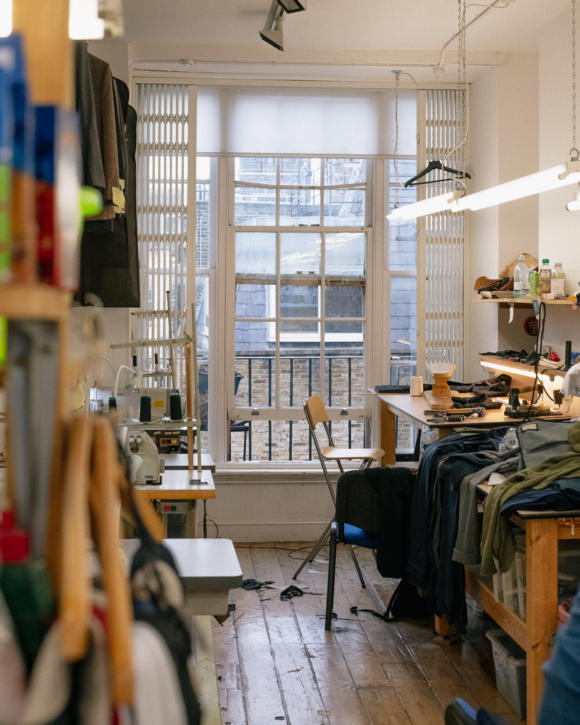
The various parts of the front of a bespoke jacket are normally sewn together by hand. This hand 'padding’ attaches the canvas that give the chest its structure, and hand sewing shapes the lapel too.
It's often used as a sign of ‘real’ bespoke, along with creating a personal paper pattern. Very few ready-to-wear suits have it - so very little made-to-measure has either - and as a general rule of thumb this twin definition works.
However, as you might expect, there are nuances and exceptions. The point of a personal pattern is not that it is an end in itself, but that it suggests there will be a good amount of alteration during the fitting process. We covered that in a previous article in this Anderson & Sheppard series here.
Hand padding is the same. Because it’s so labour-intensive, it is a decent sign that other, less obvious handwork will also go into the suit. The fact you can see those pin pricks on the underside of the lapel suggests the iron will also have been used to shape the jacket in more subtle ways.
And then there are exceptions. There’s a good argument, for example, that there’s less point in hand padding with a lightweight make of jacket, as you get from tailors in the south of Italy.
The role of padding also varies with the style of a jacket. Henry Poole pads its lapels by machine, but does the chest by hand; Anderson & Sheppard prioritises hand-padding the lapel because unlike Poole, it wants a more rounded and rolling style to its lapels.
As with any complex craft, there are levels, and once you get beyond the first one or two even the tailors start arguing about the point of parts of the process.
However, none would argue that the shape of my Anderson & Sheppard jacket - which is the focus of this mini-series - would be possible without hand padding.
The general 3D shape of the chest wouldn’t be achievable without handwork, and the particular style of the A&S front wouldn’t be possible without their coatmakers’ particular techniques.
This point of this article is to illustrate them, with the help of coatmaker Frances (below), who put together the stonewashed-linen jacket we’ve been following through the series.
Frances works in the roof of 11 St George St, the longstanding tailor’s nest that has Whitcomb & Shaftesbury on the floor below. It’s five minutes from the A&S headquarters on Old Burlington Street.
The roof is great for coatmaking, as there’s plenty of light - half the ceiling is skylights. But this also makes it warm, and the four flights of stairs dissuade all but the most necessary trips to the outside world.
Frances sits on her bench as we talk, padding the chest of a jacket across her knee. Tailors tend to do this because it gives natural shape to the chest as they sew, zig zagging across the layers of material.
But it’s also good because you have to be close to the garment, making use of both hands. The finger of one hand feels the prick of the needle pushed through by the other, before redirecting it back up.
“It’s hard on the fingers,” says Frances, showing off the callous on the finger responsible for feeling the tip of the needle each time.
Frances will get down from the bench when she’s shaping a lapel, however, because she likes to do that around its outside edge.
You can see that in the photo above. When this is done, you can see the effect this and the hand sewing has on the roll of the lapel.
Anderson & Sheppard has always been known for ‘soft’ tailoring. I put that word in inverted commas because since the growth in popularity of southern Italian tailoring, A&S is far from the softest around - just one of the softest on the Row.
However, there is a substantial difference between A&S and its more structured peers in London. For example, the padding on the lapel of an A&S jacket doesn’t run right to the break line (the line where the lapel folds over) but stops a little short. This means it rolls more easily, and doesn’t stay as sharp.
Context is important again, because that rolling is still less than a Neapolitan jacket. Personally I like how the lapel rolls on a two-button A&S, but prefer the three-button roll on a Neapolitan, largely because it seems to fit more naturally with a Neapolitan’s straight lapel.
I’ve tried both with A&S, and opted for two buttons with this current jacket for that reason. You can see the roll in the image below, taken during a fitting.
There are other small differences too, such as the fact A&S doesn’t run the canvas under the armhole of the jacket. This makes it more comfortable, but detractors would say less clean.
Frances also pointed out the way she sews by hand around the inside edge of a collar canvas (below) to shape it. Some tailors do this just with an iron, but Frances says that can drop out over time, so she prefers to draw it in with sewing.
It’s hard for tailors to specifically compare techniques, because few use more than one, or see customers from multiple tailors in order to compare them. Even as an experienced customer, so many different crafts combine in the final garment that it’s often hard to say something was specifically caused by one technique.
Tailors tend to stick with what works for them, and Frances has certainly been doing that, after more than 30 years with A&S. In fact, the other tailor in the workshop when we visited was her son, who joined the industry a few years ago.
“I started off working in the West End, but then worked from home when I had children,” explains Frances. “Then years later my son wanted to apprentice here, so I came back in. Now we’re here everyday and it feels like nothing’s changed.”
This article is the fourth going in depth on the bespoke tailoring process, in the same way Permanent Style used to do when it first started. Those posts were shorter, but still, we did once do 13 posts on my first pair of Cleverley shoes.
The previous three articles in this series are:
The last piece will focus on the final resulting jacket.
Photography here: Alex Natt @adnatt


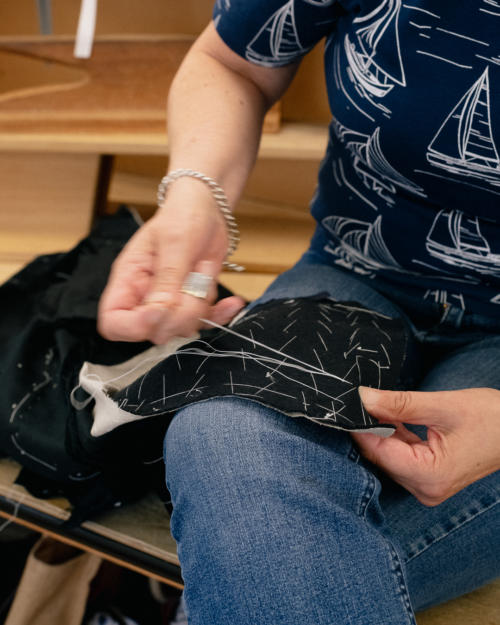
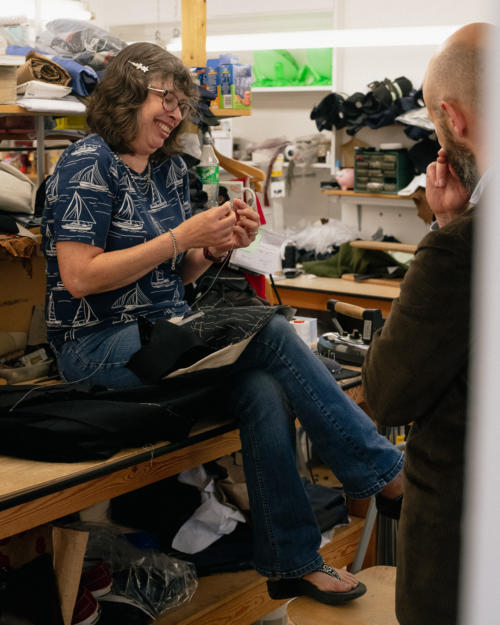
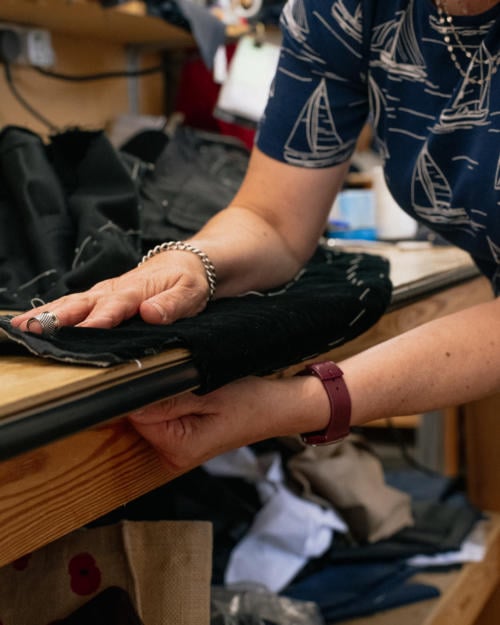
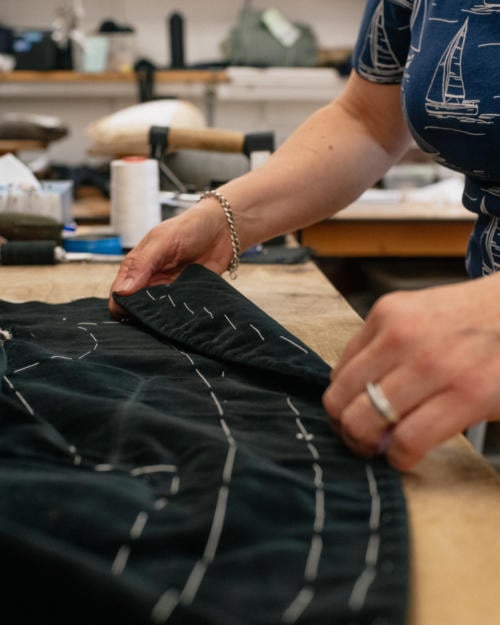
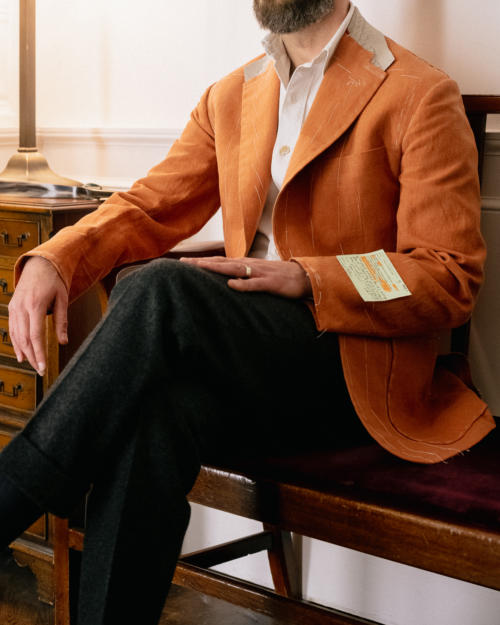
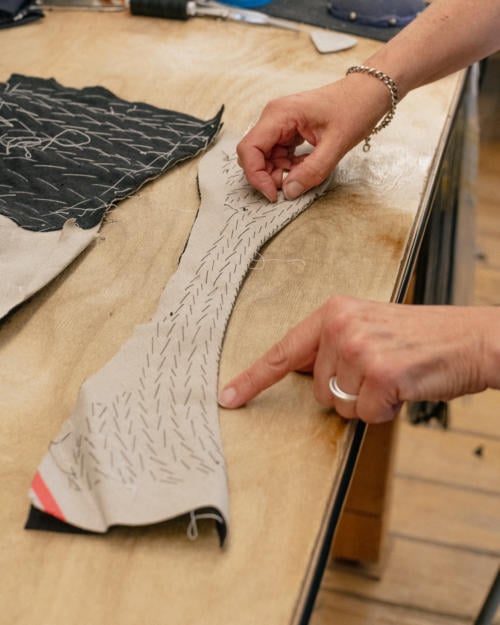
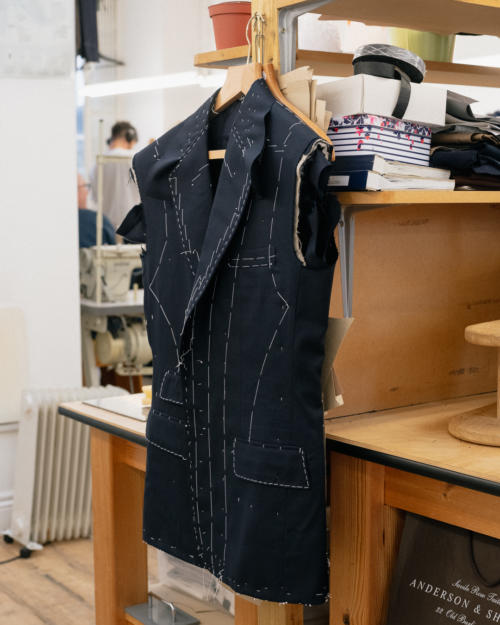
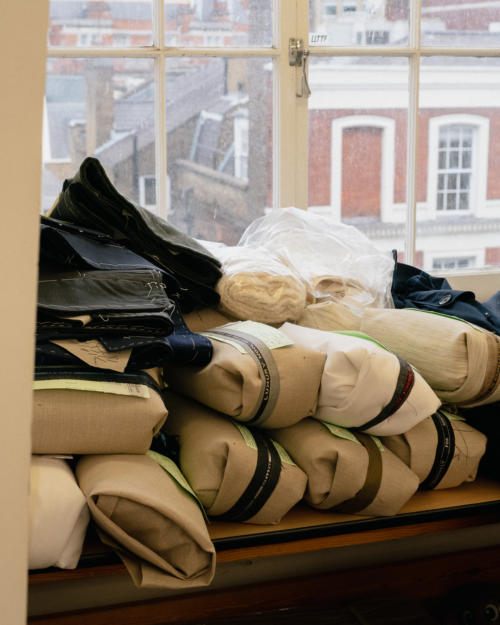


























I had my first ‘bespoke’ jacket by a tailor near St Paul’s last year.
When I got the completed jacket I was a little surprised that the lapel was ‘flat’ . I expected something akin to a ‘carpet roll’.
(That was as a result of seeing too many PS articles and photographs and expecting the same).
I now realise that short of winning the lottery that level of bespoke is beyond me.
Therefore, I’ve lowered by expectation of what bespoke I can expect.
However, the issues raised in this article , and more generally in this blog, are precisely why ‘tailors’ have ‘mixed views’ of PS .
They wouldn’t get together and define a standard (other then ‘meterage’ of where a suit is made …sigh) but are upset when folk read PS and dare to ask probing questions.
(Trust me … before having my bespoke done I rattled afew of them. Like most creative types tailors are a strongly opinionated bunch ).
Keep informing us … and upsetting ‘them’.
Thank you , Simon.
I may be wrong but I have never thought of PS’s purpose or tone as being to ‘rattle’ or ‘upset’ tailors. I really enjoy articles like this one that give an insight into a craft skill but realise they don’t make me an expert. Sometimes a little knowledge really can be a dangerous thing as it doesn’t equate to a tailor’s sometimes decades of experience which perhaps should be taken into account in our interactions with them.
Absolutely Ian, I couldn’t agree more.
May I clarify .
I think yes “a little bit of knowledge” and a tailors “years of experience” inevitably lead to a clash .
Rather like the clash between those grounded in one way of doing things being not so receptive to other ideas.
A normal human reaction to change.
But I think much of this in tailoring may be due to the lack standardisation of the term bespoke.
May I also add those ‘rattled’ or ‘upset’ are often pseudo-bespoke (think offshore ‘MTM’ advertised as ‘bespoke’) .
I could be wrong, but I think the roll is more function of style than of quality of bespoke. A good roll can’t be achieved without hand padding and handwork, but it is a style point, and I don’t think all bespoke tailors want a strong roll, and so the hand padding may be there, but hasn’t been used to create a prominent roll.
Yes, true
Nice article Simon. I’ve always wondered about the various views toward a hand-padded canvas.
Do you think that it’s possible for someone *to control the roll, and shape, of the various layers whilst using a specialised padding machine*? If so, do you think the results would be similar to hand-padding the canvas?
I mean, if the answer is yes, then this could be a very compelling way to cut down labour intensity (barring capital costs).
Thanks William.
I don’t know enough about the machinery side of it to be able to tell, but I imagine it should be. The biggest issues are probably flexibility (varying the roll depending on the tailor, the style etc – easy by hand, requiring a programming level by machine perhaps) and the small size of the potential market, which will limit interest from manufacturers.
The latter is usually the biggest obstacle across many high-end, niche products. It’s why people end up building their own looms, as factories in Italy did with old English knitwear ones, and the Japanese have done countless times with denim and jersey etc. Often it’s that necessity to create your own machinery that leads to the diminishing returns you get with higher prices. Like many specialisms I guess.
I think you are right; thank you!
It would actually be interesting to hear more about the machinery side, particularly perhaps from someone at Poole or the like where I imagine the choice to use it is deliberate, as opposed to a necessity due a certain price point.
Sure, good point
I agree that these articles are helpful and interesting. Equally, I also believe a little knowledge is a dangerous thing.
I think one can trust to experience. One rarely buys more than one suit from a new tailor and while one can ask questions, I would personally be loathe to start opining on how the suit is made, even after having many suits made by many different quality tailors, and off the rack, for many years. I would tend to look at the suits made by the tailor, either on others, in their shop, or using Permanent Style, or its equivalents ( of which of course there are none ?).
I have not ( yet ) had a suit made by A & S but hope to one day, perhaps.
I think a very common error is to assume lesser quality bespoke is inferior to the very best made to measure / off the rack suits. This is particularly the case if one does not have an unusual body type and / or one is not a fetishist of finishing.
i think the biggest difference between a good quality suit / jacket and a poor one is how it ages, and how it should get better and better, fitting to you increasingly, while a poor quality suit rapidly shows its stripes in its shoddy construction.
Agree on low bespoke v high MTM, and it’s a point worth making.
On the ageing, a handmade canvas should also adapt slightly to your shape over time, though not always very noticeably. But again, there are makers doing MTM with hand padding etc.
I think it is perfectly acceptable, on the first visit to a new tailor, to ask them about their construction methods, providing you don’t then say you’d prefer then to do “x” or “y” differently. Their method is their method. If, for some reason, it doesn’t suit you, go elsewhere.
Given that you would be unlikely to visit a tailor for the first time without a bit of research or recommendation, I’d be inclined to let that be your guide.
Once you get drawn into hand vs machine padding, you then go down the rabbit hole of how close the stitching is. That way madness lies.
Agree 100%
I’m intrigued by the inclusion of using an iron in forming jackets etc. I can see how a shaped piece of canvas can be stitched in such a way as to provide a permanent shape but I always assumed ironing would only temporarily affect it – does the heat and/or steam mould the shape then? Having spent years ironing uniforms and pressing trousers I know that only lasts a fairly short time.
It does, yes, and it can be permanent too. We’re actually working on separate coverage of this, so I’ll have more details and specific examples soon
Thank you, Simon – another post to look forward to.
Here’s a helpful video that both illustrates hand padding and explains its intended effect. The advantages of hand over machine stitching are obvious once you understand its purpose. Where applicable, each stitch determines the curvature of the fabric, and current machines don’t have an efficiency advantage over a tailor when that level of precision is required. Though in some areas the padding is just for adding structure and attaching the canvas to the outer (i.e. no curvature work), in which case there’s no need for handwork.
Also, pin pricks on the underside isn’t necessarily an indicator of handwork. As the linked video explains, some tailors work hard to ensure no visible pricks (harder to achieve the thinner the fabric). I’ve also had machine padded jackets with pricks under the lapels.
Thanks Ben, and good clarification on the last point – though I didn’t realise you could have those pricks with a machine-padded lapel. Interested to know which brand that was from. At the very least, I guess, those pricks would be perfectly regular, which would give it away a little?
All my jackets from a tailor called Cicchini are machine padded—on a Strobel in their factory in NYC I believe. The ones in fine worsteds show pricks in the lapels. Anything thicker (twills, certainly woolens) do not. Theoretically they’re maybe more regular than hand padded ones but practically it’s hard to tell. I don’t really fetishize handwork and focus on the silhouette; the Cicchini lapels roll well but not as well as top line bespoke work.
Now I understand what you mean when you talk about the roll of a lapel. I like this feature. Making an essentially two-dimensional fabric curve into three dimensions is like promising this fabric is touchable. It encourages the observer to reach up and rub the lapel between her fingers.
The point you make about ‘soft tailoring’ is very interesting.
Personally I’ve always thought them the masters of the game when it comes to this and have therefore never really understood the fascination with the Neopolitans.
I have 3 single A&S SB suits in my wardrobe and consider them my finest. They just beat everybody hands down when it comes to style, comfort and quality.
This is a very helpful comment, thank you.
This is a fascinating and interesting article. Simon, is Frances an actual A&S employee or a private contractor? If I understand the situation correctly, a number of Row companies use outside coat and pant makers in addition to in-house staff. Do I have this right?
For most people, their coatmakers and trouser makers are freelance, yes, and can in theory take work from anyone. In practice, however, they agree to do the work from one tailor as a priority, and don’t have much time for others. Especially at the moment, when everyone is so busy
Thank you for the education.